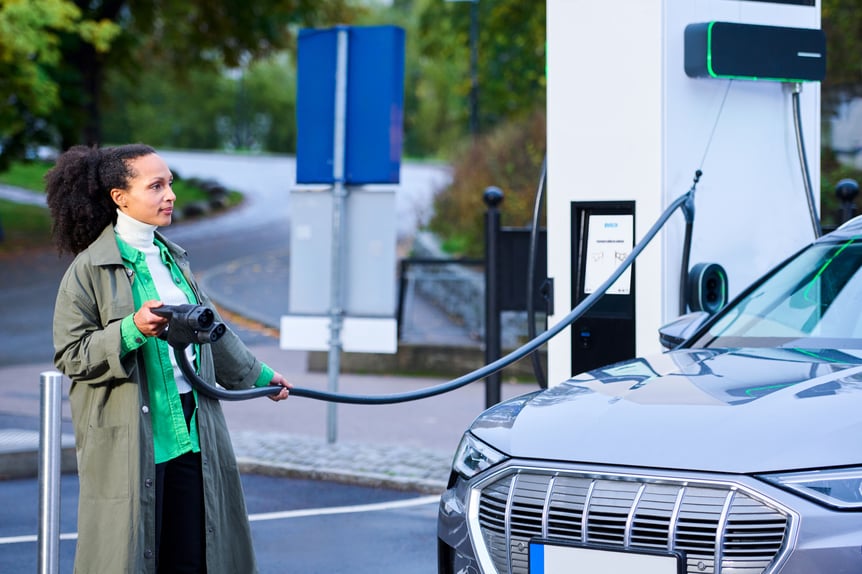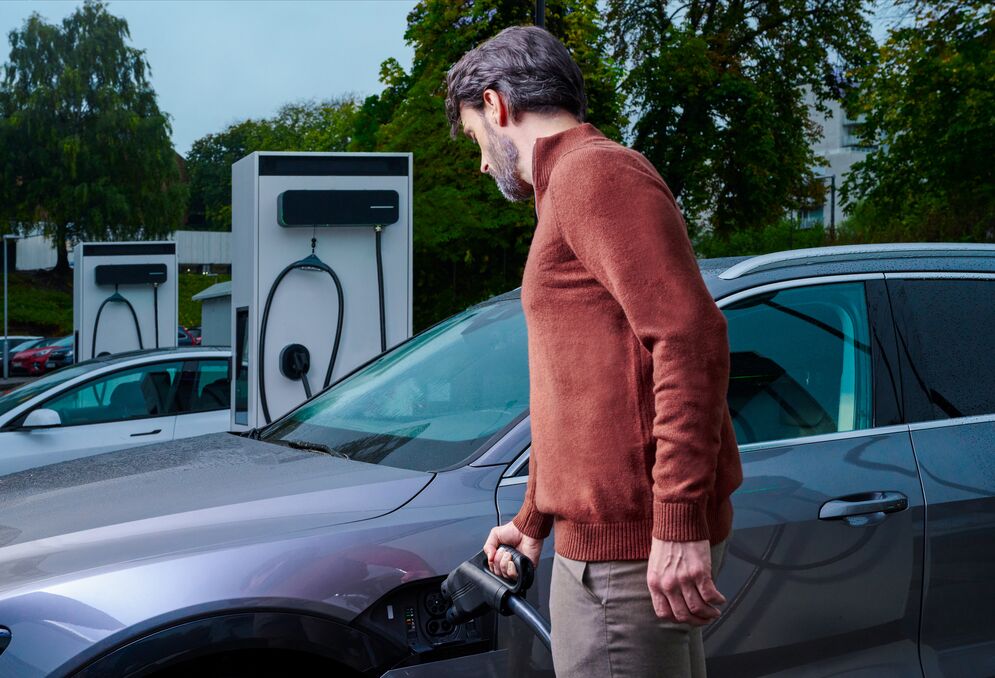
Last updated on May 19, 2023
How much an electric vehicle (EV) costs to charge depends on a range of factors, including where you charge, the type of charging station you use, the price of electricity, and what time you charge.
Still, in 2023 charging an EV is almost always cheaper than filling a car with gas.
gas vs electric cars
| Region |
Average yearly spending on: | |
| Gasoline | EV charging | |
| US 🇺🇸 | $3.000* | $750 - $1.000* |
| EU 🇪🇺 | € 1,379* | € 800 - € 1,200* |
| UK 🇬🇧 | £1.171* | £815 - £1.076* |
| *These estimated prices are for illustrative purposes only and represent the yearly average spending on either gasoline or electricity, based on the latest average electricity prices per kWh available, per country/continent as of the date of writing/updating this article. The actual cost of charging an electric vehicle or refueling an Internal combustion engine vehicle may vary depending on various factors. |
||
This article takes a closer look at the cost differences (and factors affecting those) between charging an electric car and filling a car with gasoline. Read or full article, or jump down with one of the shortcuts below:
Last updated on May 19, 2023
How much an electric vehicle (EV) costs to charge depends on a range of factors, including where you charge, the type of charging station you use, the price of electricity, and what time you charge.
Still, in 2023 charging an EV is almost always cheaper than filling a car with gas.
gas vs electric cars
| Region |
Average yearly spending on: | |
| Gasoline | EV charging | |
| US 🇺🇸 | $3.000* | $750 - $1.000* |
| EU 🇪🇺 | € 1,379* | € 800 - € 1,200* |
| UK 🇬🇧 | £1.171* | £815 - £1.076* |
| *These estimated prices are for illustrative purposes only and represent the yearly average spending on either gasoline or electricity, based on the latest average electricity prices per kWh available, per country/continent as of the date of writing/updating this article. The actual cost of charging an electric vehicle or refueling an Internal combustion engine vehicle may vary depending on various factors. |
||
This article takes a closer look at the cost differences (and factors affecting those) between charging an electric car and filling a car with gasoline. Read or full article, or jump down with one of the shortcuts below:

Potential EV drivers are uncertain about the costs
All over the world, the types of vehicles on our roads are changing. What began with Tesla’s rise as a niche electric vehicle manufacturer has grown into the beginning of a worldwide transition to electric mobility, with EV sales now making up more than 14 percent of all new cars sold. This rise has been driven by strong interest from drivers, favorable government regulations, and a rush to reduce the carbon footprints of businesses and consumers alike.
With all this momentum, what’s standing in the way of those who are considering an EV taking the plunge?
Simply put: it’s still uncertainties over price. According to our research, some of the main barriers for consumers on the fence are the price tag of EVs and how much they will cost to run, especially when compared to gas alternatives.
So, is charging an EV cheaper than filling an internal combustion engine (ICE) car with gas? More often than not, the answer is “yes,” however, the full picture is a bit more complex and depends on a range of factors which we’ll dive into below.

Is EV charging cheaper than gas?
The first thing to look at when determining whether an EV is cheaper to run than a gas car is the price of fuel, in other words, that of electricity and gasoline. These depend on a range of factors, including your location, electricity and fuel prices, and the type of EV charging.
On top of this, plenty of other things come into play, including fuel economy, government regulations, and the type of engine the gas car has.
However, the answer is not “if”, but “how much” you will save with an EV compared to a gas car. Let’s look at a few key factors to determine how much it costs to charge an EV or a gas car.
The gasoline perspective
Gas prices
When it comes to gas prices, there are a few factors that determine how much you’re going to pay at the pump. While taxes, distribution, and refining costs make up roughly 45 percent, the cost of crude oil itself commands the lion's share of gas prices.
When the price of crude oil fluctuates—as it often does due to the law of supply and demand, global crises, and political factors—we see prices at the pump rise and fall. Since the beginning of this century, the price of gas in the U.S. has experienced significant fluctuations.
According to research by the U.S. Energy Information Administration, the retail price for a gallon (3.78 liters) of gasoline is highly volatile and varied from a high of nearly $5 in June 2022 to a low of $3.66 in May 2023.
While the price of oil in each country fluctuates, you can check the current average price in your country or region here. However, at the time of writing this article, most of the EU and the UK sit between $1.5 and $1.8 per liter, and the U.S. hovers around $3.8 per gallon (+- 3.79 liters).
Type of engine
The type of engine plays a major role when determining fueling costs and is something that many consumers take into account when deciding to purchase a new gas car. Here’s a brief overview of the ICE market today:
-
Gasoline engine
The majority of passenger vehicles are equipped with gasoline-powered ICEs. These vehicles generally burn the most fuel per mile, emit the most CO2, and cost the most to run, although differences between diesel and hybrids are becoming negligible as all have become more efficient over the years. -
Diesel engine.
Compared to their gasoline counterparts, diesel engines consume 10-20 percent less fuel thanks to more efficient engine operation. These efficiencies are due to burning a heavier, more energy-dense fuel which is more efficient but also costs less than gasoline. On average, the worldwide cost for diesel is $4.69 per gallon, versus $4.97 for gasoline. However, diesel also emits more pollutants than gasoline and is subject to higher taxes in certain parts of the world. -
Hybrid engines
Powered by an ICE and an electric motor, hybrid vehicles have even lower fuel consumption because the battery supplements gasoline driving to help maximize fuel efficiency. Running costs for hybrid vehicles depend on whether it’s a plug-in or gas-fueled hybrid, but overall, they’re often cheaper than gas or diesel cars.
Size of vehicle
Another determining factor to consider is the size of the vehicle. The heavier a vehicle is, the more energy is needed to move it. Heavier vehicles have greater rolling resistance, which in turn, contributes to increased fuel consumption. As a standard, lighter vehicles tend to be more fuel-efficient and better for the environment as well as more cost-efficient to run. The general rule of thumb is that the bigger the car, the more expensive it will be to run. However, weight factors impact cars with ICEs more than hybrids and electric vehicles, which can recover a portion of the energy lost.

What is Fuel economy?
A vehicle's fuel economy is essentially how far it can drive on a specific amount of fuel. In the US and UK, this is usually measured in miles per gallon (mpg), while in Europe and the rest of the world, it’s typically measured in liters per 100 kilometers.
When calculating how much it costs to fill up a car with gas, this is an essential number to know. Loosely speaking, anything under 8 liters per 100km is pretty good, between 8 liters and 12 liters is average, and anything over 12 liters is considered a relatively low fuel efficiency. For instance, at the low end of the spectrum, a Honda Civic—considered one of the most fuel-efficient, gas-only cars by the U.S. EPA—has a fuel efficiency of around 7 liters per 100km.
Government regulation
Another consideration when it comes to fuel economy is the government levies and taxes on vehicles with low fuel economy ratings, high levels of pollution, or heavier vehicles in general.
For instance, in the US, vehicle manufacturers are already required to pay a "gas guzzler" tax on the sale of cars with exceptionally low fuel economy. Additionally, in some countries like the Netherlands, how much road tax you pay depends on the weight of your car as well as how much pollution it emits.
These regulations are set to increase as many city, state, and federal governments move to ban vehicles that emit carbon or other pollutants. On the other hand, here’s the list of incentives European governments offer when purchasing an EV.

The EV perspective
How much does it cost to charge an electric car?
When you’re driving a gasoline or a diesel vehicle, calculating fuel costs is relatively easy. You know how much you’re used to paying per liter, and you know how much it will cost on average to fill up your tank.
When it comes to the cost of charging an electric vehicle, it is a little more complicated as there are different levels of charging, which all come with different costs. These depend on several factors, including where you charge, the price of electricity, and at what time you charge.
Home charging
Charging at home – either with the cable that came with your EV or a dedicated charging station – will let you take advantage of the lowest price per kilowatt-hour (kWh)—the electric equivalent of a gallon or liter of fuel.
As you use your residential energy supplier, there is no “middle-man” charging extra for the service, and you’ll simply pay the price you pay for electricity at your home.
However, home charging can be slower than public charging stations as the power output of a home is often lower. Check out our detailed article for everything you need to know about charging an EV at home, including charging times at different kWh outputs, and the different charging station options available.
Energy prices and EV charging
In the US, the average price per kWh is around $0.15 while in the EU, that number is comparatively higher at around €0.28. That said, this cost varies greatly depending on where you are in both regions. For example, the cost per kWh jumps to around €0.33 on average in Germany but is only €0.15 in Poland.
How does this translate when charging an EV? Well, if you're looking to fully charge a Nissan Leaf with a 62 kWh battery in Europe, you'll pay around $17 with a maximum range of 364 km.
However, if you’re looking to charge a Tesla Model X with its larger, 100 kWh battery, it will cost closer to $28 with a range of up to 625 km.
Fuel economy for electric vehicles
An electric vehicle’s “fuel efficiency” is based on the number of kilometers that the vehicle does on a single kilowatt-hour (kWh).
As an average small electric vehicle can travel 6,5 kilometers (4 miles) per kWh, if you typically drive your car 1,600 km (1,000 miles) a month, then you’ll need at least 250 kWh to charge it properly.
At $0.15 per kWh that will cost you $37.50 a month in the US and at the European average of €0.28, that will cost you €70 a month.

Public charging
Public charging is more expensive than charging an EV at home as the location sets the baseline cost of energy, and the charge point operator often adds a premium.
How much public charging costs vary on a range of factors. The tariff is based on the location you charge at, the network you use (and any roaming fees for using other networks), the time you charge, the number of kWh you consume, as well as a potential membership fee the supplier may decide to charge you.
Generally speaking, however, public charging will always be more expensive than charging at home.
Fast charging
Fast charging, also known as level 3 charging or DC charging, is capable of charging a vehicle within minutes instead of hours. Fast chargers are significantly quicker than regular AC charging stations, taking between 15 and 45 minutes to charge most passenger electric vehicles up to 80 percent—making it quick and easy to charge on the go.

Fast charging is, however, the most expensive public charging option and can double (or in some cases even triple) the cost per kWh. With fast charging, you’re paying for the convenience of charging your vehicle quickly – and the investment by the charge point operator. The price difference, however, depends on the location at which you charge and whether the charging station bills by the minute or by kWh.
The price of fast charging is more comparable to the price of filling up with gas, however, it’s not usually an everyday experience for most drivers. Instead, fast charging is reserved for quick top-ups on long trips, while cheaper home or AC public charging is used for day-to-day charging.
Electric cars vs gas cars
With all these variables, it can be hard to get an accurate idea of how much charging an EV costs versus filling up a car with gas. That said, we can look at average numbers to get an idea.
The typical American family spends about $3,000 a year on gasoline, while in the Netherlands—a smaller country where gas prices are significantly higher—the average driver spends on average €1,379 a year on gas. In the UK, that number sits at around £1,171 a year.
In comparison, EVs tend to be significantly cheaper to run than gas cars. EVs only cost around $750 of electricity per year on average, and even the most power-hungry EVs will only cost around $1,000 per year, three times lower than the yearly average US spending on gas.
In the UK, medium-to-large EVs cost between £815 and £1,076 to operate, while in Germany, one of Europe’s most expensive electricity markets, the average driver travels roughly 14,000 km, which at €0.33 per kWh, equates to around €816 per year.
*Disclaimer: Energy prices fluctuate greatly and may be higher due to the current energy crisis.
Learn more about EV charging
Besides comparing charging costs compared to the cost of fuel, there are many other questions people have about driving an electric car. For example, what is the average range of an electric car today? What is the difference between AC and DC charging, and how does it work? Where can I charge my car, and how long will it take me? Have a look at our in-depth beginner’s charging guide to answer all of these questions and more.
Related articles

Smart Charging for Solar EV Systems: What is possible today?
There are a variety of smart solutions available, capable of optimizing your solar EV charging system in different...

Can solar EV charging save you money?
Charging your EV using household solar panels can indeed save you money on your utility bills. How much money solar EV...

How to optimize your solar set-up for charging electric cars at home
There are several ways EV drivers can optimize a homegrown solar system to ensure their EV recharging needs are met....

